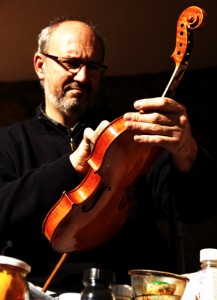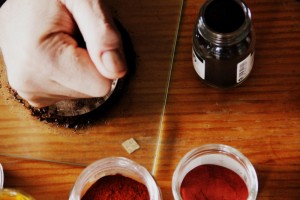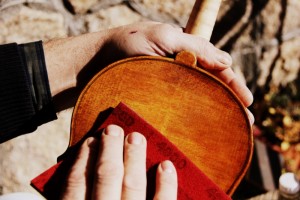es
MI BARNIZ
 La elección y elaboración de un buen barniz es quizás la tarea más difícil en la construcción de un instrumento de cuerda. Resulta determinante en su aspecto final pero además juega un papel muy importante en el sonido. Un buen instrumento, que en blanco suena amplio y rico en armónicos, podemos estropearlo con un mal barnizado. Muchos instrumentos han revivido al librarlos de una capa de barniz demasiado gruesa o demasiado dura. Con un exceso de barniz podemos perder armónicos y capacidad de proyección del sonido y el instrumento resulta asordinado. Un barniz demasiado duro endurece también el sonido y lo hace áspero, impersonal, y poco agradable al oído. Con un barniz demasiado blando el sonido puede ser inconsistente y hueco, además de no aguantar un uso normal sin deteriorarse. Por tanto lo deseable es un material flexible, que no salte con cualquier golpecito y que deje vibrar las tapas con libertad. Debe tener también una buena transparencia que nos permita apreciar la belleza de la madera, y presentar cierta resistencia al calor y al desgaste ya que tiene que durar mucho tiempo.
La elección y elaboración de un buen barniz es quizás la tarea más difícil en la construcción de un instrumento de cuerda. Resulta determinante en su aspecto final pero además juega un papel muy importante en el sonido. Un buen instrumento, que en blanco suena amplio y rico en armónicos, podemos estropearlo con un mal barnizado. Muchos instrumentos han revivido al librarlos de una capa de barniz demasiado gruesa o demasiado dura. Con un exceso de barniz podemos perder armónicos y capacidad de proyección del sonido y el instrumento resulta asordinado. Un barniz demasiado duro endurece también el sonido y lo hace áspero, impersonal, y poco agradable al oído. Con un barniz demasiado blando el sonido puede ser inconsistente y hueco, además de no aguantar un uso normal sin deteriorarse. Por tanto lo deseable es un material flexible, que no salte con cualquier golpecito y que deje vibrar las tapas con libertad. Debe tener también una buena transparencia que nos permita apreciar la belleza de la madera, y presentar cierta resistencia al calor y al desgaste ya que tiene que durar mucho tiempo.
 Aunque en este campo un luthier nunca acaba de investigar, yo estoy empleando un barniz al aceite, que a pesar de que tiene el inconveniente de que tarda en secar, cumple en buena medida estos requisitos. Lo confecciono yo mismo con resinas y aceites naturales de primera calidad así como con pigmentos y colorantes también en su mayoría naturales y usados desde antiguo.
Aunque en este campo un luthier nunca acaba de investigar, yo estoy empleando un barniz al aceite, que a pesar de que tiene el inconveniente de que tarda en secar, cumple en buena medida estos requisitos. Lo confecciono yo mismo con resinas y aceites naturales de primera calidad así como con pigmentos y colorantes también en su mayoría naturales y usados desde antiguo.
 Cuando hablo de barnizado no me refiero solo a la capa final que vemos y tocamos, sino también a la preparación previa de la madera. Esta cumple varias funciones. Por un lado consigue homogeneizarla, ya que siempre hay partes con diferente densidad y porosidad. Por otra parte, consigue que cuando el instrumento recibe la luz ésta se refracte y produzca un efecto muy bello, ya que cambian las tonalidades según desde el ángulo que se mira. Esto es algo en lo que eran grandes maestros los autores clásicos italianos y que yo intento conseguir. Es en definitiva una labor compleja en la que tan importantes son las materias utilizadas como la forma de hacerlo y debemos tener en cuenta que no hablamos solo del mueble sino que la meta final debe ser un buen sonido.
Cuando hablo de barnizado no me refiero solo a la capa final que vemos y tocamos, sino también a la preparación previa de la madera. Esta cumple varias funciones. Por un lado consigue homogeneizarla, ya que siempre hay partes con diferente densidad y porosidad. Por otra parte, consigue que cuando el instrumento recibe la luz ésta se refracte y produzca un efecto muy bello, ya que cambian las tonalidades según desde el ángulo que se mira. Esto es algo en lo que eran grandes maestros los autores clásicos italianos y que yo intento conseguir. Es en definitiva una labor compleja en la que tan importantes son las materias utilizadas como la forma de hacerlo y debemos tener en cuenta que no hablamos solo del mueble sino que la meta final debe ser un buen sonido.
us
MY VARNISH
 The choice and elaboration of a good varnish is perhaps the most difficult task in the making of a stringed instrument. It is crucial in its final appearance and also plays an important role in sound production. A good instrument that sounds vibrant and rich in harmonics before varnish can be spoiled by an unsuitable varnish. Many instruments have come alive again after being liberated of a coat of varnish too thick or hard. An excess of varnish could result in losing harmonics and sound projection potential with the resulting muting of the instrument. Too hard a varnish can also result in a hardening of the sound, making it rasping, impersonal and undesirable under the ear. Too soft a varnish can result in producing an inconsistent hollow sound as well as not standing up to wear and tear of normal use without deterioration. So the ideal coat would be therefore a flexible varnish which allows both plates to vibrate freely and doesn’t break off after having any small knocks or little accidents. Moreover it should show a nice transparency permitting us to appreciate the underlying beauty of the wood as well as showing a resistance to heat and general damage since it should last for a lifetime.
The choice and elaboration of a good varnish is perhaps the most difficult task in the making of a stringed instrument. It is crucial in its final appearance and also plays an important role in sound production. A good instrument that sounds vibrant and rich in harmonics before varnish can be spoiled by an unsuitable varnish. Many instruments have come alive again after being liberated of a coat of varnish too thick or hard. An excess of varnish could result in losing harmonics and sound projection potential with the resulting muting of the instrument. Too hard a varnish can also result in a hardening of the sound, making it rasping, impersonal and undesirable under the ear. Too soft a varnish can result in producing an inconsistent hollow sound as well as not standing up to wear and tear of normal use without deterioration. So the ideal coat would be therefore a flexible varnish which allows both plates to vibrate freely and doesn’t break off after having any small knocks or little accidents. Moreover it should show a nice transparency permitting us to appreciate the underlying beauty of the wood as well as showing a resistance to heat and general damage since it should last for a lifetime.
 Although in this area the violin maker never really finishes his investigation I usually use an oil based varnish that, although it takes time in drying completely, meets to a large extent all these requirements. I make it myself using resins and natural oils of top quality, together with pigments and colorings mainly natural, used from antiquity.
Although in this area the violin maker never really finishes his investigation I usually use an oil based varnish that, although it takes time in drying completely, meets to a large extent all these requirements. I make it myself using resins and natural oils of top quality, together with pigments and colorings mainly natural, used from antiquity.
When mentioning varnish, I don’t ever refer exclusively to the final layer that we see and touch, but also the previous preparation of the wood. This has two functions: on the one side it helps to homogenize it, since there are always some parts with a different density  and porosity than the others; on the other hand this ensures that when the instrument is touched by light, the light becomes refracted producing a beautiful gem-like effect, whose shades dance and change according to the angle that we look at. This is something the great Italian masters stood out, and something I also strive to achieve.
and porosity than the others; on the other hand this ensures that when the instrument is touched by light, the light becomes refracted producing a beautiful gem-like effect, whose shades dance and change according to the angle that we look at. This is something the great Italian masters stood out, and something I also strive to achieve.
The truth is that it is a complex art where the materials themselves and the way they are manipulated are equally important. We have to take into consideration not only the instrument look but also how it will sound.
